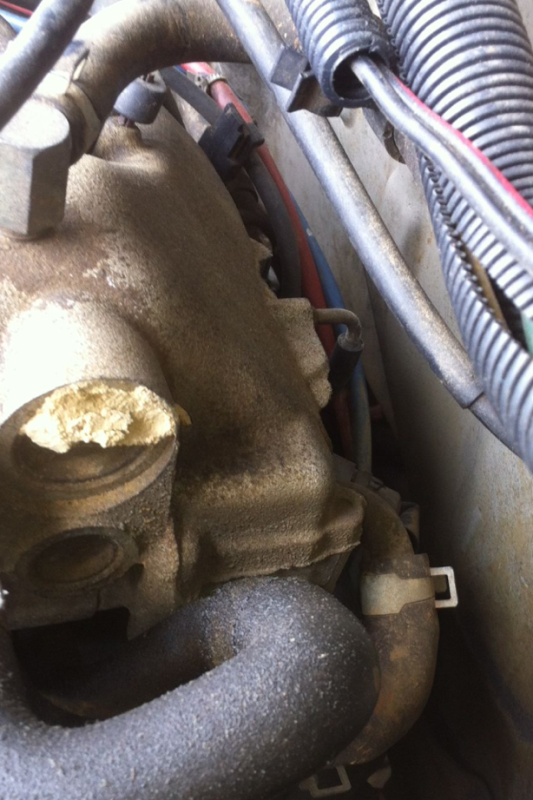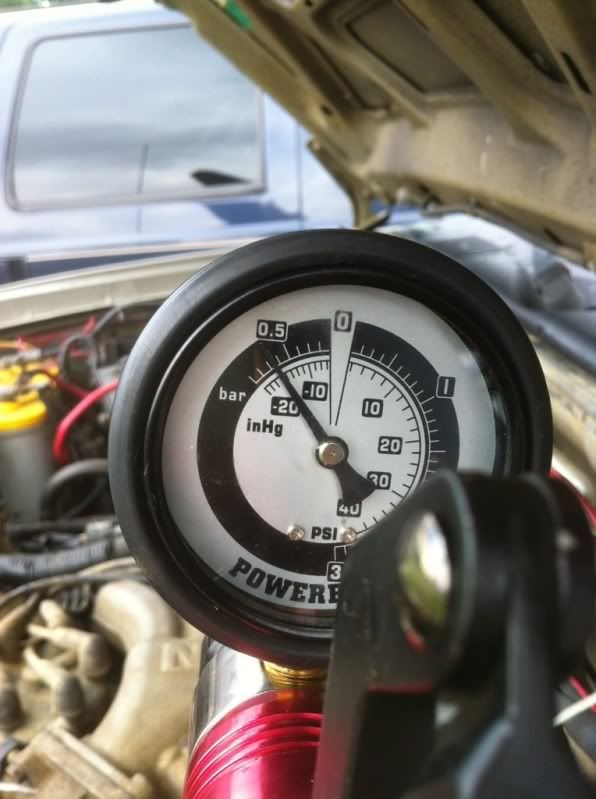I put a new radiator in the truck today and it made no difference. It only took 5 minutes on the hwy for the temp to get above normal.
I’ve got an OEM Nissan thermostat on the way and if that does not fix it I am taking it to a different shop. After that the truck will be sold.
Are you not going to consider the connection of a vacuum gauge in the event that this problem is caused by an exhaust restriction?
Vacuum gauges are cheap and pretty much last a lifetime as a very valuable and functional tool.
I am willing to do that but I have not been able to find the exact location on my motor needed to hook up, or what the vacuum measurement is I’m looking for or looking out for.
A vacuum gauge can be plugged in to any port from the intake manifold as long as it’s below the throttle plate; meaning NOT from the throttle plate up through the air filter assembly.
I often plug them into the vacuum hose for the fuel pressure regulator as that is usually easy to get to.
A normal manifold reading will vary based on engine condition, altitude, barometric pressure, etc but a good engine normally has a rock steady 17-20" of vacuum at idle. When the throttle is blipped quickly the needle should drop instantly to zero.
An exhaust restriction can come across 2 ways.
On a severe restriction the needle may be hesistant about dropping to zero and also slow about returning to the normal at idle reading.
On a mild restriction, what I’ve often noticed is that the needle may drop quickly to zero but on the return when the throttle is released the needle will drop back a few inches higher than normal and then make a slow return back to normal.
Hope that helps and as an example of how a restriction can affect engine temps consider the guy who pulled up in front of our shop doors one time. He had a Cadillac that was barely chugging and smoking. When I raised the hood I saw that both exhaust manifolds were actually glowing red hot and this was due to the converter being clogged. Needless to say, the engine was wiped.
That engine had gotten so hot that it burnt the paint off the hood on both sides.
I rented a gauge but still don’t see where to hook it up. The only thing that looks like a port is the evap service port. Can you see somewhere in these pics to hook up?


Any small hose fitting on the intake manifold (stamped “NISSAN”).
So i just unplug one end of the hose on the manifold and hook up the gauge there?
How about this hose on the back of the intake against the firewall?

I think I’m doing it wrong.
Here is what it reads idling. When I blip the throttle the needle moves from here to about one measuremebt to the right then goes right back to here. So, it goes from 15 to 14; then back to 15.

15" is kind of low. There’s some issue here.
When you blipped the throttle did you (or a helper) jab it at least nearly to the floor?
A light tap will not drop the vacuum much.
Not that far. I probably jumped it to 4k with my hand, but to the floor would be about 6400
I agree; that 15 is a bit low. A low and steady reading usually points to a compression or late cam/ignition timing issue. A quick rummage back through all of the posts and I did not see, or either overlooked, where compression was tested and what the numbers were.
If the throttle was opened quickly and allowed to slam shut just as quickly you should have seen the gauge needle drop to or almost zero before quickly returning to 15; low as it is.
Not dropping very much could point to an exhaust restriction.
Should I investigate a clogged cat or bad exhaust valve first?
Was a compression test done or did I overlook that? You might run a compression test and if the numbers appear to be low then you might unbolt the header pipe from the converter and perform the compression test again as a clogged exhaust can affect numbers.
There’s also the issue of making dead sure that the ignition timing is correct as per the label on the underhood sticker.
Checking back through all the posts I see that you have done a lot of things but never checked the ignition timing even three peop;e have suggested it. Late ignition timing could explain the overheating, lack of power and low vacuum reading. If the timing is correct, unbolt the cataylitic converter (it will be very noisey) and hook it to a heavy load and head uphill. If it doesn’t overheat, then you have found the problem.
Do I need a timing light to check ign timing or can a scan tool read that?
Also, I have not done a compression test. There is a spark plug on the back of the motor that I can not access with the tools I have. For that cylinder to be tested I think someone else will have to do it.
This engine has a distributor, so a timing light is needed.
You can still do a compression test on the cylinders with easy plug access.
If those compression #'s are pretty even and there’s no feel like a light miss you can assume the “mystery cylinder” is about the same.
Any shade tree mechanic with grey hair will have a timing light, if you can’t find one to borrow, Harbor freight has one for 20 bucks and 20% off coupons are easy to find.
@oldtimer11
I’m a professional mechanic with grey hair and a timing light
I guess I fit the mold . . .